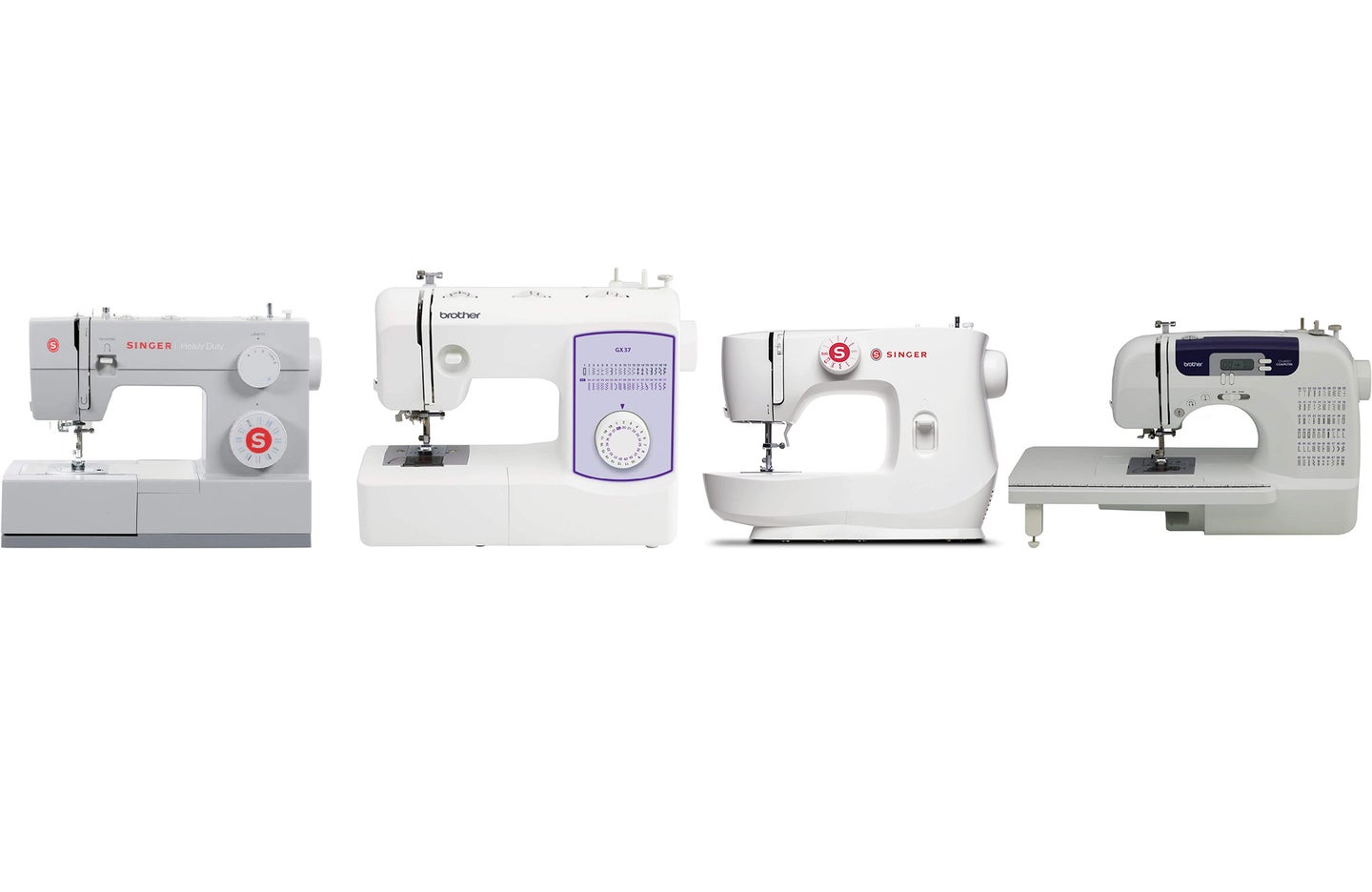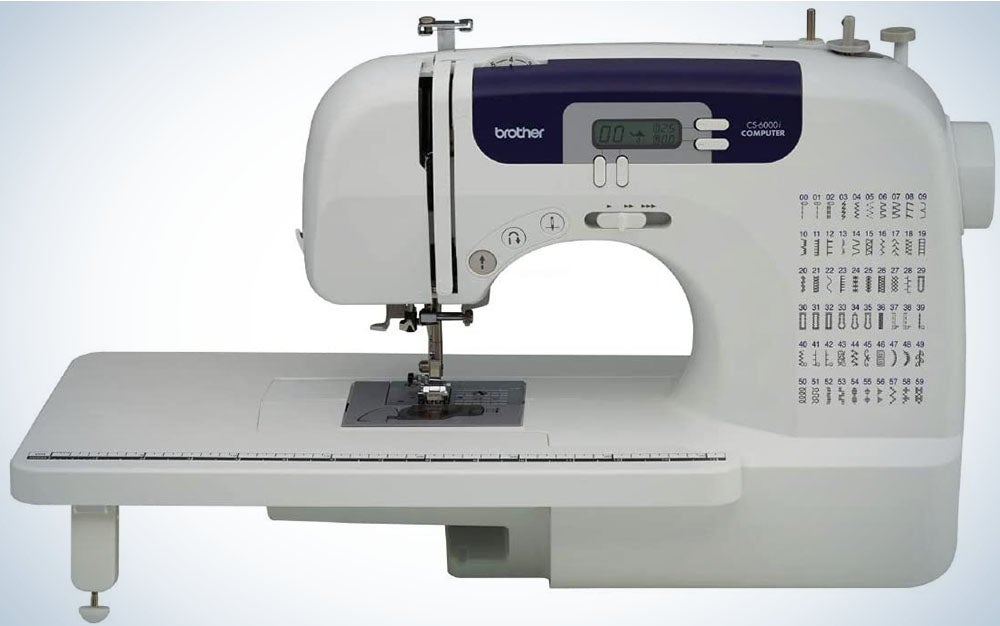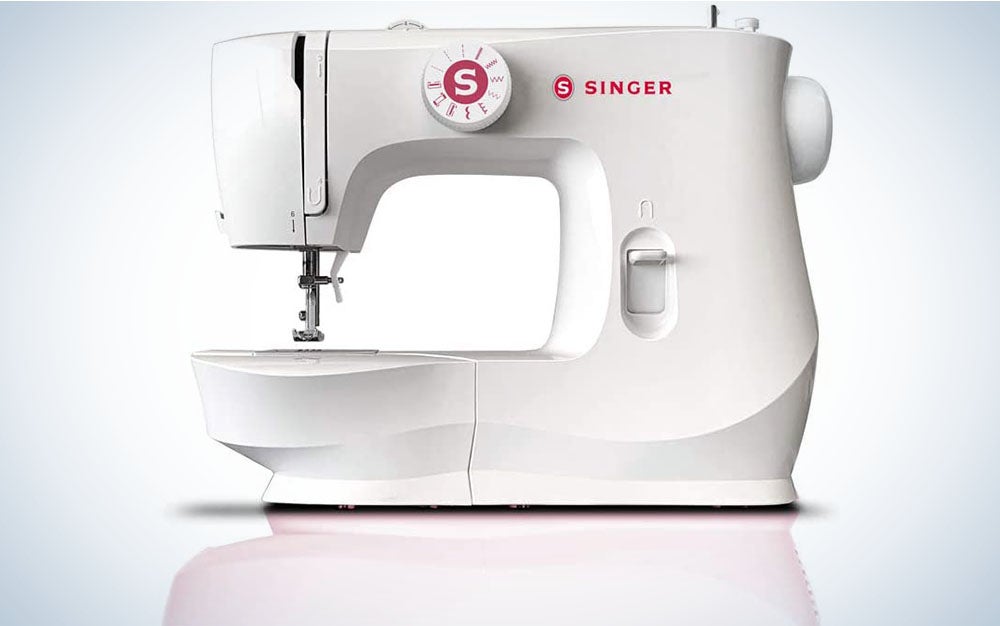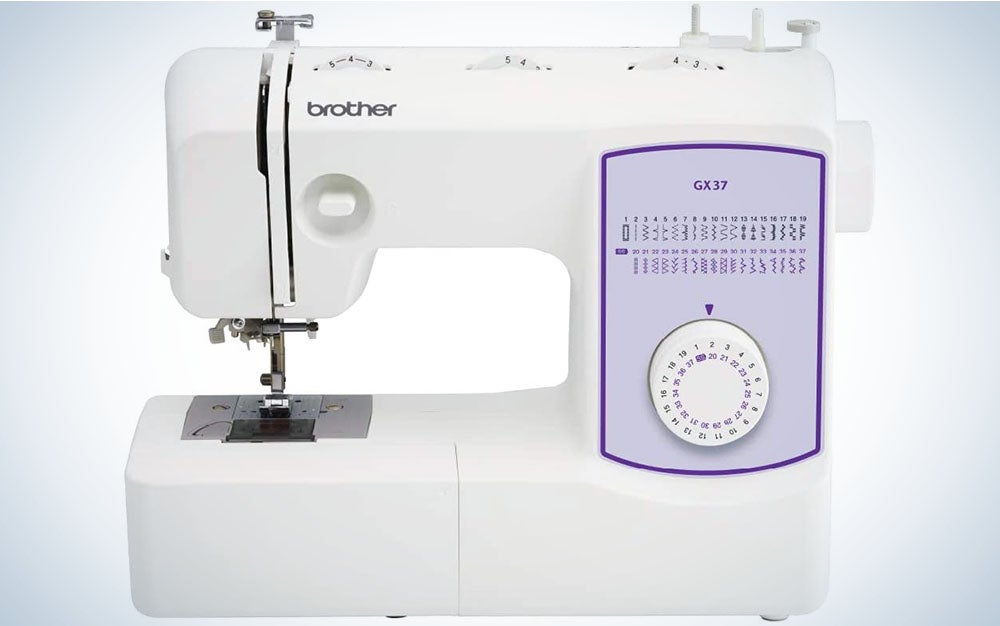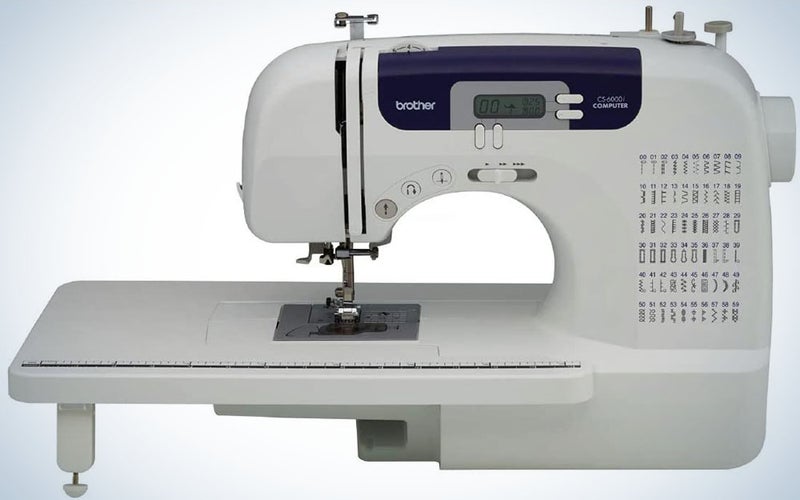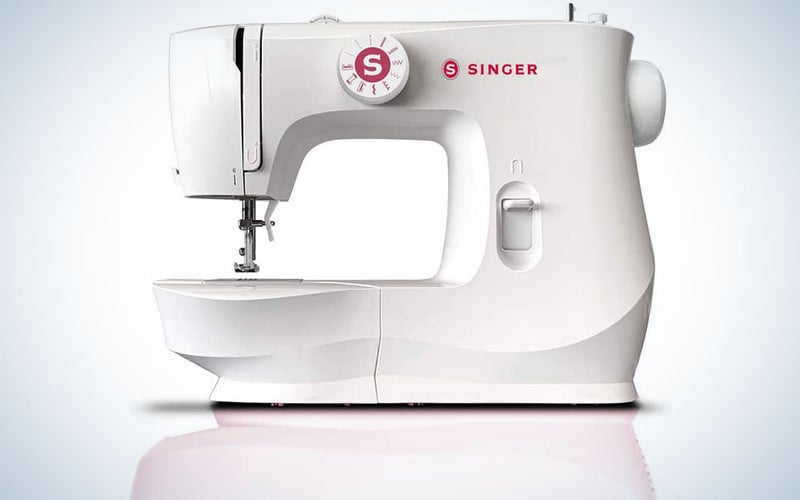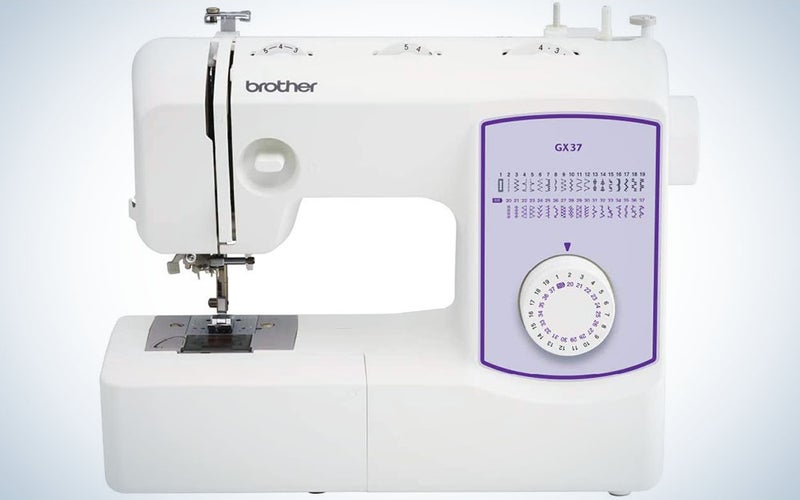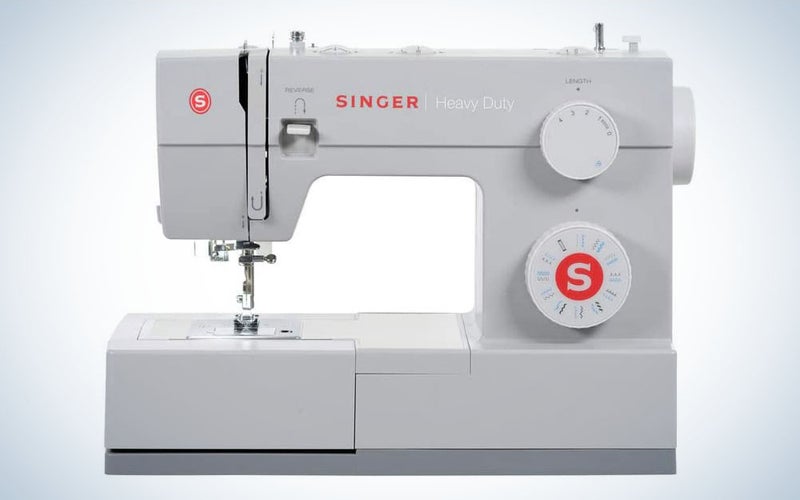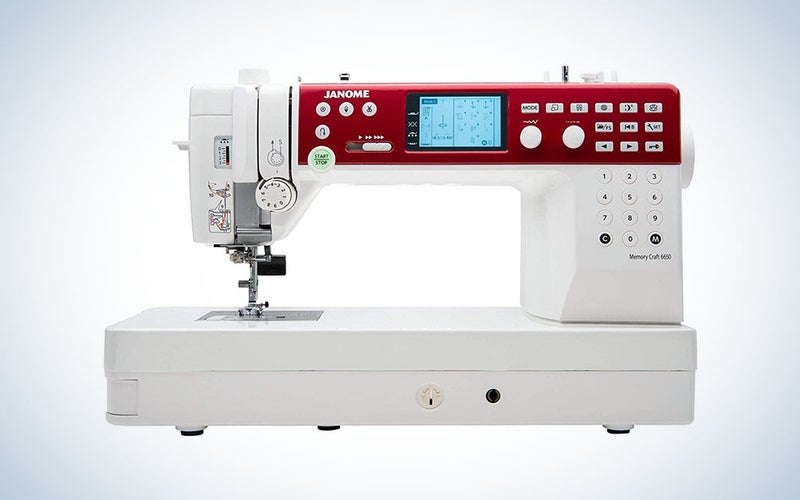We may earn revenue from the products available on this page and participate in affiliate programs. Learn more ›
A resurging interest in sewing is fueled by sewing machines that let you do amazing things with a needle and thread. Whether you’re making your own custom window treatments, repairing a shirt, or DIY-ing your own formal wear, a sewing machine with the right stitches and features can breeze through delicate or heavy-duty fabrics like tissue paper. Finding the best sewing machine depends on the level of your sewing skills and what exactly you hope to make. Beginners don’t need a plethora of stitches, free-motion capabilities, or specialized presser feet. Advanced sewists, on the other hand, may need a wide range of stitches, a long free arm, and an extended sewing table to make their creations. If you’re somewhere in the middle, there’s a model out there for you, too. Here are our recommendations for the best sewing machines.
- Best overall: Brother CS6000i Sewing and Quilting Machine
- Best budget: SINGER Mechanical MX60 Sewing Machine
- Best basic: Brother GX37 Sewing Machine
- Best heavy duty: SINGER 4423 Heavy Duty Sewing Machine
- Best for quilting: Janome MC6650 Sewing and Quilting Machine
How we selected the best sewing machines
I’ve used my beloved Brother sewing machine for the last 15 years, and I believe newbies and seasoned sewists deserve a machine that treats them right. The criteria for these sewing machines started with ease of use and went to frame materials, versatility, and extra features and accessories.
Ease of use: How easily can you adjust the thread tension? Thread the machine? Is the manual helpful? Does the machine come with an instructional DVD? Does it have an automatic needle threader?
Frame materials: The materials in the internal frame affect durability. There should be some metal, but all metal is even better.
Versatility: How many stitches does it have? Can you use it for quilting or embroidery? Does it do free motion stitching or have a free arm? (A free arm has space underneath, so you can sew sleeve cuffs)
Extra features and accessories: How many presser feet does the machine include? (Don’t get too caught up on this one. You can always buy these separately.) Does it have memory features? What’s included with the machine, like extra bobbins, screwdriver, and other tools needed to care for the machine?
The best sewing machines: Reviews & Recommendations
Best overall: Brother CS6000i Sewing and Quilting Machine
Why it made the cut: As the best sewing machine overall the CS6000i brings a little bit of everything to the sewing table with a wide table, hard case, nine presser feet, and 60 built-in stitches that easily let you expand your sewing abilities.
Specs
- Type: Computerized
- # of sewing feet included: 9
- Bobbin type: Drop-in
Pros
- Easy to thread and install bobbin
- Nice range of stitches without being overwhelming
- Helpful speed adjustment setting
Cons
- Tension adjustment can be tricky
With 60 built-in stitches, the CS6000i offers a wide range of stitches but not enough that beginners will get intimidated. The computer lets you switch through stitches and adjust stitch length and width with the press of a few buttons. If you’re looking for a sewing machine with table, the wide table on this model works well for both garments or quilts. It comes with a hard case, an accessory that’s not often included with sewing machines.
Threading directions are built directly onto the casing to speed up the threading process. A drop-in bobbin also adds to the overall ease of use. An adjustable speed option helps out beginners. Rather than the speed being controlled by pedal pressure, you can adjust the slider to set the sewing speed. Even if you press the pedal all the way down, the sewing machine will only go as fast as the set speed.
Tension adjustments, which are notoriously tricky on most machines, can be difficult with this model. It might take some practice and different presser feet to get it right. For more options, here are the best-rated Brother sewing machines.
Best budget: SINGER Mechanical MX60 Sewing Machine
Why it made the cut: This Singer sewing machine has the durability of much more expensive models but keeps things simple with an automatic stitch length and width, making it an excellent budget-friendly choice.
Specs
- Type: Mechanical
- # of Sewing Feet Included: 3
- Bobbin type: Drop-in
Pros
- Six most common stitches, including buttonhole
- Durable full-metal frame
- Lightweight and portable
Cons
- Cannot adjust the stitch length and width
The Singer MX60 saves dollars on extra stitches and features but provides excellent durability and only the most used six stitches. It even has a four-step automatic buttonhole stitch and a buttonhole foot as one of the three included presser feet.
With a full-metal interior frame, this is a machine made to last, yet its compact size remains lightweight and portable. It’s the kind of machine you can take to a friend’s house or a sewing class. If you’re looking for a cheap sew machine, it’s reasonably priced as well.
This small sewing machine does come with a feature that’s both a pro and a con. It automatically adjusts the stitch length and width, which is to say you can’t change them. That’s one less step for you to worry about, but there are times when you’ll miss that feature. For example, sewing thick fabrics often works better with some extra stitch length. A zigzag stitch may need to be narrower or wider for different fabrics, too. So for beginners, it’s one less thing to worry about, but you might miss it when you get more experience. Here are some more high-quality Singer sewing machines.
Best basic: Brother GX37 Sewing Machine
Why it made the cut: This is the best sewing machine for beginners. It gives a simple way to build skills with reliable performance and enough stitches for beginners to expand their abilities as they learn and master the art of sewing.
Specs
- Type: Mechanical
- # of Sewing Feet Included: 6
- Bobbin type: Drop-in
Pros
- Automatic needle threader
- Includes instructional DVD
- Small footprint and lightweight
Cons
- Durability
The Brother GX37 keeps things simple with mechanical dials controlling everything from stitch selection to length and width. Beginners will also appreciate that it comes with an instructional DVD to walk them through those first few steps like threading, winding the bobbin, and how to adjust tension.
Threading instructions are built into the front of the machine with easy-to-see and understand numbers and arrows. Beginners won’t get overwhelmed with the 37 stitch choices and six included presser feet. This model is also lightweight with a small footprint, so financially and storage-wise, it’s not a huge commitment if you find out sewing isn’t for you.
Where the GX37 could potentially disappoint is durability. It does not have an all-metal interior frame. The use of less durable materials keeps it lightweight, but there are parts that may break more easily.
Best heavy duty: SINGER 4423 Heavy Duty Sewing Machine
Why it made the cut: Not every sewing machine can handle leather, canvas, and other heavy fabrics, but this Singer takes them on and sews through them like butter.
Specs
- Type: Mechanical
- # of Sewing Feet Included: 3
- Bobbin type: Drop-in
Pros
- Extra high presser foot lift for thick fabrics
- Heavy, metal frame improves durability
- Automatic one-step buttonhole feature
Cons
- Requires regular use or lubrication
This heavy-duty Singer sewing machine tackles a wide range of fabrics from chiffon and silk to leather and denim. It’s the latter two that go along with the Singer’s heavy-duty build. Thick fabrics can cause broken needles and other issues in less durable machines. However, this model’s all-metal frame pushes right through without a pause. Thick fabrics can also pose problems with presser feet. If the foot can’t lift high enough, the fabric gets stretched as it goes under the foot. This mode has an extra high presser foot to make sure those thick fabrics have enough room.
It may come with fewer pressure feet than most sewing machines, only three, but the mechanical functioning, durability, and versatility offer great options for beginning to advanced users. The last standout feature is the single-step buttonhole feature. Buttonholes can confound even experienced sewists. This model gives users a break and does it all once you set it in the right place.
On the downside, this heavy machine needs regular lubrication or use. Otherwise, the metal frame can get locked up if it hasn’t been used for a while.
Best for quilting: Janome MC6650 Sewing and Quilting Machine
Why it made the cut: A breathtaking number of stitches, 20 memory banks, a high presser foot lift, and an aluminum body make this the best sewing machine for quilting. Get your hands on a machine that will make quilts for years.
Specs
- Type: Computerized
- # of Sewing Feet Included: 12
- Bobbin type: Drop-in
Pros
- 20 memory banks store stitch sequences
- Nine one-step buttonholes
- Needle up/down memory
- Extra-long free arm and sewing table
Cons
- Expensive
Janome is well-known for the quality of their machines, and their machines come with the price to prove it. Quilters will love the 172 stitch options, two alphabets, and extra-long free arm and sewing table. A large LCD display makes it easy to see the settings and make adjustments as needed. This model also features 20 memory banks to store stitch sequences for quilting.
Among the plentiful stitch and accessory options are nine one-step buttonholes, 12 presser feet, and two easy-change needle plates. This model also features an up/down needle memory to help make precise turns. This model gives sewists the power of choice and creativity. However, the high price is a commitment not meant for the beginner or casual user. For additional options, here are some good sewing machines for quilting.
Things to consider before buying a sewing machine
Mechanical vs. Computerized
Mechanical sewing machines have mechanical dials, levels, and buttons that control stitch selection, stitch length, stitch width, and tension settings. These models cost less, weigh less, and offer simplicity of use. Mechanical models are also easier to maintain and clean because there’s no computer involved. However, they have a smaller stitch selection and may not offer as many functions.
Computerized sewing machines have a digital display and hundreds of stitch options. The most advanced machines may also have a touchscreen to scroll through menus or download embroidery patterns. The more common ones have buttons that let you scroll through the stitches and make adjustments to length and width. These machines offer more of everything, including dollar signs on the price tag. The downside is they aren’t always the easiest to use, and there is the possibility of computer problems, which takes more than a good cleaning to fix.
Purpose
What do you plan on sewing? Making garments is different from quilting or embroidery. Some models let you do it all from a single machine, while others are more specialized. A standard sewing machine can do embroidery and quilting, but it won’t have presser feet and stitch settings that make quilting or embroidery easier and more precise.
Skill Level
The majority of sewing uses two stitches—a straight stitch and a zigzag stitch. Beginners don’t need more than that either, which makes buying a machine with hundreds of stitches unnecessary. A simple model with a few basic stitches and a buttonhole stitch will take care of the majority of sewing needs. However, as you gain skills and expand your sewing repertoire, you may want a more advanced set of stitch options. Advanced sewists may want to download their own patterns directly onto the machine, a feature that’s only found on the most advanced embroidery or quilting sewing machines.
Automatic Buttonhole
It might seem strange to base your sewing machine choice on a single feature. But if there’s one feature most people find they miss, it’s an automatic buttonhole feature. Buttonholes are notorious for their difficulty. A machine with this automatic feature does the work for you. It’s still a process and takes some practice, but if you are doing any sewing with a buttonhole, you’re going to need this feature. You might have to do a couple of practice rounds to get the right placement, but an automatic buttonhole and buttonhole foot will do the rest of the work for you.
FAQs
Q: How much does a sewing machine cost?
The cost for a sewing machine can range from less than $130 for basic models to more than $1,600 for sewing machines that perform many functions. Options like The Brother CS6000i Sewing and Quilting Machine are good for both beginners and will continue to be useful for people as they develop their sewing skills.
Q: Can you embroider with a sewing machine?
You can embroider with a sewing machine. It’s not as easy, exact, nor will a standard machine have as many options as an embroidery machine. You’ll need an embroidery hoop, embroidery thread, and a tutorial (there are many free ones online) to create your first embroidered creation with a standard machine.
Q: Who invented the sewing machine?
Thomas Saint invented the first sewing machine in 1790. However, there’s only evidence of the first sewing machine, not an actual model still in existence. Saint’s original design wasn’t widespread for many years until improvements in the design made it practical for widespread use in the clothing industry.
Q: How to set up a sewing machine?
Sewing machine designs vary from model to model. However, there are some universal features involved in the setup process. First, place the sewing machine on a sturdy, flat surface. Plug the pedal into the machine. Some models have the electrical cord and pedal on the same cord, while others have separate cords for each. Before turning on the machine, thread the needle following the instruction manual or guide imprinted on the machine (a common feature on modern sewing machines). Drop the bobbin in, pull its thread through, and choose your stitch. From there, you should be ready to go.
Final thoughts on the best sewing machines
The Brother CS6000i Sewing and Quilting Machine provides a balance of features with ease of use that make it our top choice. Beginners can grow and use it for years, while advanced sewists will get a high-quality machine with an array of stitches and a wide sewing table. However, if you’re looking for the best sewing machine that can take heavy use day in and day out, including heavy fabrics, look no further than the SINGER 4423 Heavy Duty Sewing Machine.
